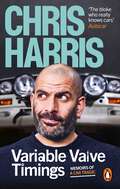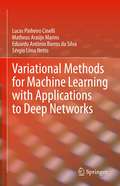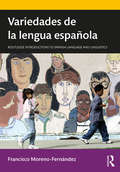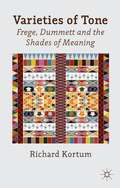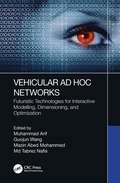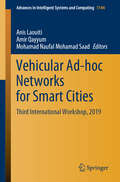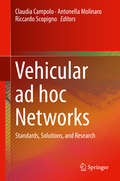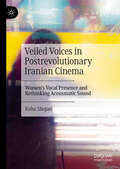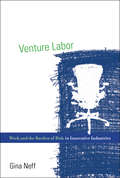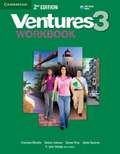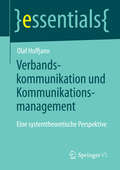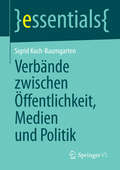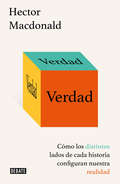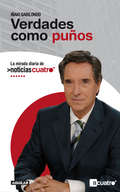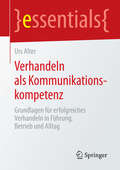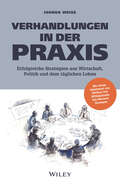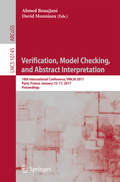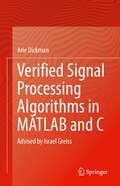- Table View
- List View
Vanity Fairs: Another View of the Economy of Attention
by Georg FranckThis book offers readers a comprehensive introduction to the economy of attention from the perspective of the basic motive of the pursuit of attention: self-esteem. As a jumping-off point, it states the stark equation at the heart of this economy— that the self-esteem one can afford depends on one’s income of appreciative attention. The information markets in which participants compete to play a role in the consciousness of others are described as ‘vanity fairs’. Since the pursuit of self-esteem is highly effective when it comes to mobilizing human energies, vanity fairs are not just playgrounds of individual passions, but have been utilized by society since time immemorial as markets for particularly challenging demands.Starting with an analysis of the interface that connects the social economy of attention with the intra-psychic economy of self-esteem, the book then examines two main cases in point: modern science and the post-modern media culture. On the one hand we have scientists working for a ‘wage of fame’, who invest their own attention into getting the attention of others. On the other, today’s dominant media have left the sale of information behind to focus solely on the attraction of attention, which is sold as a service to the advertising industry. In each case the use of attention as a means of payment is key to its phenomenal success. But success comes at a price: the dark side of this monetization of attention is a kind of ’climate change’ in the collective mental sphere which threatens the very existence of our social fabric.
Variable Valve Timings: Memoirs of a car tragic
by Chris HarrisTyre destruction, power slides and continuous droolingChris Harris has driven more cars than most people could ever dream of. His vast knowledge is legendary. He calls it 'unhinged geekery'. But we call it infectious enthusiasm, adrenaline-fueled escapism and peerless journalistic rigour and integrity.And then there are his famous skills at the wheel, from city cars to rally cars, F1 to vintage, not forgetting the Guinness World Record 3.4km sideways in an electric car.And now for the first time, Harris is going all out with that unhinged geekery, and takes us down the road of his life-long adventure with the automobile - from the Scalextric track to the Nürburgring 24 Hour, via his own formative low-powered Somerset version of The Dukes of Hazard.A highly individual, petrol-soaked life story that's all down to variable valve timings.
Variational Methods for Machine Learning with Applications to Deep Networks
by Lucas Pinheiro Cinelli Matheus Araújo Marins Eduardo Antônio Barros da Silva Sérgio Lima NettoThis book provides a straightforward look at the concepts, algorithms and advantages of Bayesian Deep Learning and Deep Generative Models. Starting from the model-based approach to Machine Learning, the authors motivate Probabilistic Graphical Models and show how Bayesian inference naturally lends itself to this framework. The authors present detailed explanations of the main modern algorithms on variational approximations for Bayesian inference in neural networks. Each algorithm of this selected set develops a distinct aspect of the theory. The book builds from the ground-up well-known deep generative models, such as Variational Autoencoder and subsequent theoretical developments. By also exposing the main issues of the algorithms together with different methods to mitigate such issues, the book supplies the necessary knowledge on generative models for the reader to handle a wide range of data types: sequential or not, continuous or not, labelled or not. The book is self-contained, promptly covering all necessary theory so that the reader does not have to search for additional information elsewhere. Offers a concise self-contained resource, covering the basic concepts to the algorithms for Bayesian Deep Learning;Presents Statistical Inference concepts, offering a set of elucidative examples, practical aspects, and pseudo-codes;Every chapter includes hands-on examples and exercises and a website features lecture slides, additional examples, and other support material.
Variedades de la lengua española
by Francisco Moreno-FernándezVariedades de la lengua española ofrece un panorama general de la variación dialectal y sociolingüística en el espacio hispanohablante, presentado por uno de los más prestigiosos expertos en la materia. La lectura de este manual permitirá familiarizarse con los rasgos que distinguen las diferentes variedades geográficas del español, con una comprensión adicional de las causas históricas y políticas de sus diferencias y de sus implicaciones sociales. Cada capítulo incluye sugerencias de lecturas complementarias y propone temas de debate e investigación, así como un glosario que explica la terminología algo más especializada. Complementariamente, el texto remite a materiales audiovisuales disponibles en la red que permiten una aproximación más directa a las variedades del español. Estas páginas son de interés tanto para los hispanohablantes nativos como para los no nativos interesados por la diversidad dialectal. Asimismo, esta obra puede servir como texto primario, de apoyo o complementario para los estudiantes, el profesorado y los hispanistas interesados por el conocimiento de las variedades geográficas y sociales de la lengua española.
Varieties Of Tone
by Richard D. KortumIn clear and lively prose that avoids jargon, the author carefully and systematically examines the many kinds of subtly nuanced words or word-pairs of everyday discourse such as 'and'-'but', 'before'-'ere', 'Chinese'-'Chink', and 'sweat'-'perspiration', that have proven resistant to truth-conditional explanations of meaning.
Vehicular Ad Hoc Networks: Futuristic Technologies for Interactive Modelling, Dimensioning, and Optimization
by Muhammad ArifWith the evolution of technology and sudden growth in the number of smart vehicles, traditional Vehicular Ad hoc NETworks (VANETs) face several technical challenges in deployment and management due to less flexibility, scalability, poor connectivity, and inadequate intelligence. VANETs have raised increasing attention from both academic research and industrial aspects resulting from their important role in driving assistant system. Vehicular Ad Hoc Networks focuses on recent advanced technologies and applications that address network protocol design, low latency networking, context-aware interaction, energy efficiency, resource management, security, human-robot interaction, assistive technology and robots, application development, and integration of multiple systems that support Vehicular Networks and smart interactions. Simulation is a key tool for the design and evaluation of Intelligent Transport Systems (ITS) that take advantage of communication-capable vehicles in order to provide valuable safety, traffic management, and infotainment services. It is widely recognized that simulation results are only significant when realistic models are considered within the simulation tool chain. However, quite often research works on the subject are based on simplistic models unable to capture the unique characteristics of vehicular communication networks. The support that different simulation tools offer for such models is discussed, as well as the steps that must be undertaken to fine-tune the model parameters in order to gather realistic results. Moreover, the book provides handy hints and references to help determine the most appropriate tools and models. This book will promote best simulation practices in order to obtain accurate results.
Vehicular Ad-hoc Networks for Smart Cities: Third International Workshop, 2019 (Advances in Intelligent Systems and Computing #1144)
by Anis Laouiti Amir Qayyum Mohamad Naufal Mohamad SaadThis book presents selected papers from the Third International Workshop on Vehicular Ad-hoc Networks for Smart Cities, Paris, 2019. Future smart cities are well placed to profit from extraordinary mobile infrastructures. IWVSC'2019 brings together experts from both academia and industry to discuss recent developments in vehicular networking technologies and their interaction with future smart cities in order to promote further research activities and challenges.
Vehicular ad hoc Networks
by Riccardo Scopigno Claudia Campolo Antonella MolinaroThis book presents vehicular ad-hoc networks (VANETs) from the their onset, gradually going into technical details, providing a clear understanding of both theoretical foundations and more practical investigation. The editors gathered top-ranking authors to provide comprehensiveness and timely content; the invited authors were carefully selected from a list of who's who in the respective field of interest: there are as many from Academia as from Standardization and Industry sectors from around the world. The covered topics are organized around five Parts starting from an historical overview of vehicular communications and standardization/harmonization activities (Part I), then progressing to the theoretical foundations of VANETs and a description of the day-one standard-compliant solutions (Part II), hence going into details of vehicular networking and security (Part III) and to the tools to study VANETs, from mobility and channel models, to network simulators and field trial methodologies (Part IV), and finally looking into the future of VANETs by investigating alternative, complementary communication technologies, innovative networking paradigms and visionary applications (Part V). The way the content is organized, with a differentiated level of technical details, makes the book a valuable reference for a large pool of target readers ranging from undergraduate, graduate and PhD students, to wireless scientists and engineers, to service providers and stakeholders in the automotive, ITS, ICT sectors.
Veiled Voices in Postrevolutionary Iranian Cinema: Women’s Vocal Presence and Rethinking Acousmatic Sound
by Raha ShojaeiThis book examines the vocal presence of women in postrevolutionary Iranian cinema. The research explores the concept of the veiled voice, which conceals the bodily aspects of the voice and suppresses its discursive elements. Studying the "veiling" of women&’s voices in New Iranian Cinema, how they relate to authoritative voices, and their limitations in cinematic spaces, the book addresses the detachment of women&’s voices from their bodies in some films. The book argues that this detachment is often used as a feminist strategy to bypass constraints on female portrayal on camera. The book dissects how these voices are often marginalized within the cinematic space, either structurally, narratively, or due to patriarchal adherence. It also discusses the concept of the acousmatic voice, particularly in the context of Iranian cinema, where the female voice-off is used as a spatial veil, contributing to the marginalization of women. Although Michael Chion's concept of the acousmêtre is based on classic Hollywood cinema, this book shows that the mere presence of an off-screen voice does not ensure a predictable impact in the filmic world. In New Iranian Cinema, influenced by factors like modesty rules, the off-screen voice untethered to a body can serve as a presentational strategy rather than just a cinematic narrational device. The book also investigates the unveiling of the female voice as a subject of aesthetic admiration and desire within the cinematic realm, navigating censorship through religious and cinematic elements and explores how cinematic spaces manipulate the presence and embodiment of the unveiled voice to avoid revealing its true source. The book is also informed by the author's experience as the first woman sound designer working in the Iranian film industry.
Venture Labor: Work and the Burden of Risk in Innovative Industries (Acting with Technology)
by Gina NeffWhy employees of pioneering Internet companies chose to invest their time, energy, hopes, and human capital in start-up ventures.In the dot-com boom of the late 1990s, employees of Internet startups took risks—left well-paying jobs for the chance of striking it rich through stock options (only to end up unemployed a year later), relocated to areas that were epicenters of a booming industry (that shortly went bust), chose the opportunity to be creative over the stability of a set schedule. In Venture Labor, Gina Neff investigates choices like these made by high-tech workers in New York City's “Silicon Alley” in the 1990s. Why did these workers exhibit entrepreneurial behavior in their jobs—investing time, energy, and other personal resources that Neff terms “venture labor”—when they themselves were employees and not entrepreneurs?Neff argues that this behavior was part of a broader shift in society in which economic risk shifted away from collective responsibility toward individual responsibility. In the new economy, risk and reward took the place of job loyalty, and the dot-com boom helped glorify risks. Company flexibility was gained at the expense of employee security. Through extensive interviews, Neff finds not the triumph of the entrepreneurial spirit but a mixture of motivations and strategies, informed variously by bravado, naïveté, and cold calculation. She connects these individual choices with larger social and economic structures, making it clear that understanding venture labor is of paramount importance for encouraging innovation and, even more important, for creating sustainable work environments that support workers.
Ventures 3 Workbook (2nd Edition)
by Gretchen Bitterlin Dennis Johnson Donna Price Sylvia Ramirez K. Lynn Savage Ingrid WisniewskaVentures 2nd Edition is a six-level, standards-based ESL series for adult-education ESL. The Ventures 2nd Edition Level 3 Workbook provides reinforcement exercises for each lesson in the Student's Book, an answer key for self-study, grammar charts, and examples of a variety of forms and documents.
Ventures 3: Student's Book
by Gretchen Bitterlin Dennis Johnson Donna Price Sylvia Ramirez K. Lynn SavageVentures is a five-level, standards-based ESL series for Adult Education ESL. Each Student's Book contains 10 topical units composed of six lessons each. The two-page lessons are designed for an hour of classroom instruction. Culture notes and speaking, reading, and writing tips enrich and support exercises. Review units include sections focusing on pronunciation.
Ventures 3: Workbook
by Gretchen Bitterlin Dennis Johnson Donna Price Sylvia Ramirez K. Lynn SavageVentures is a five-level, standards-based ESL series for Adult Education ESL. The Workbook provides reinforcement exercises for each lesson in the Student's Book, an answer key for self-study, grammar charts, and examples of a variety of forms and documents.
Ventures 4: Workbook
by Gretchen Bitterlin Dennis Johnson Donna Price Sylvia Ramirez K. Lynn Savage Kristin L. JohannsenThe Workbook provides reinforcement exercises for each lesson in the Student's Book, an answer key for self-study, and grammar charts.
Ventures Basic: Student's Book
by Gretchen Bitterlin Dennis Johnson Donna Price Sylvia Ramirez K. Lynn SavageVentures is a five-level, standards-based ESL series for Adult Education ESL. Each Student's Book contains 10 topical units composed of six lessons each. The two-page lessons are designed for an hour of classroom instruction. Culture notes and speaking, reading, and writing tips enrich and support exercises. Review units include sections focusing on pronunciation.
Verantwortungszuschreibung im Journalismus: Responsibility Framing von Depressionen und Diabetes mellitus aus Kommunikator*innenperspektive
by Annemarie WiedickeDie Art und Weise, in der wir als Gesellschaft mit Gesundheit und Krankheit umgehen, wird maßgeblich durch Fragen der (Eigen-)Verantwortung geprägt: Wer ist verantwortlich dafür, dass ein Mensch erkrankt? Die Person selbst, ihr soziales Umfeld, oder strukturelle Gegebenheiten? Und wessen Aufgabe ist es, das entstandene Problem zu beheben? Wie oder wem Menschen gesundheitliche Verantwortung zuschreiben, wird nicht zuletzt durch das Framing in der journalistischen Berichterstattung beeinflusst. Einem interdisziplinären Ansatz folgend beleuchtet dieses Buch die Responsibility Frames in der Berichterstattung und ihren Entstehungsprozess – das Responsibility Frame Building. Am Beispiel von Depressionen und Diabetes mellitus werden mittels einer Kombination von Inhaltsanalyse und Leitfadeninterviews die mediale Darstellung von Verantwortung im Gesundheitskontext, die krankheitsspezifischen Vorstellungen von Journalist*innen sowie die individuellen, organisatorischen und externen Einflüsse auf die Berichterstattung beleuchtet. Die Befunde liefern einen wichtigen Einblick in Frame Building Prozesse in der journalistischen Nachrichtenproduktion. Dabei zeigt sich, dass Journalist*innen eine zentrale Rolle für die mediale Zuschreibung gesundheitlicher Verantwortung zukommt.
Verbandskommunikation und Kommunikationsmanagement: Eine systemtheoretische Perspektive (essentials)
by Olaf HoffjannIn diesem Band wird auf einer systemtheoretischen Grundlage eine Theorie der Verbandskommunikation entwickelt. In Verbänden stellen sich drei zentrale Probleme: das Problem der Legitimation gegenüber dem politisch-administrativen System, das Problem zurückgehender Mitgliederbindungen sowie die Widersprüche, die sich aus der Bearbeitung dieser Probleme ergeben. Zur Lösung dieser drei Probleme haben sich mit der Legitimationskommunikation, der Mitgliederbindungskommunikation und dem integrierten Kommunikationsmanagement drei Disziplinen ausdifferenziert, die der klassischen Verbandskommunikation zugeordnet werden können. Damit wird eine Spezialisierungs- und Integrationsperspektive gleichermaßen eingenommen: Zunächst wird zu untersuchen sein, wie die Probleme fehlender Unterstützung und der Legitimation bearbeitet werden, um anschließend zu fragen, wie die daraus entstehenden Widersprüche bearbeitet werden.
Verbände zwischen Öffentlichkeit, Medien und Politik (essentials)
by Sigrid Koch-BaumgartenDer Titel befasst sich mit dem Wandel der politischen Kommunikation von Verbänden in der Bundesrepublik Deutschland unter den Herausforderungen der Politikbeobachtung durch allgegenwärtige Massenmedien. Nach einer Einführung in die Funktionen und Bedeutung von Verbänden und Medien in der Politikvermittlung zwischen Staat und Gesellschaft werden die neuen Verflechtungen von öffentlichen, medialen und nichtöffentlichen, institutionellen Politikarenen in der Mediengesellschaft sowie deren Rückwirkungen auf die verbandliche Interessenpolitik, Organisation und Binnen- wie Außenkommunikation behandelt. Vorgestellt und diskutiert werden unterschiedliche wissenschaftliche Interpretationsansätze zum Verhältnis von Verbänden und Massenmedien.
Verdad: Cómo los distintos lados de cada historia configuran nuestra realidad
by Hector Macdonald¿Verdad o mentira? Las cosas casi nunca son tan sencillas.Un alegato a favor de la verdad en tiempos de posverdad. Hay más de una verdad acerca de casi todo. Comer carne es nutritivo, pero también perjudicial para el medioambiente. Internet difunde el conocimiento, pero también el odio. Como es lógico, cuando nos comunicamos seleccionamos aquellas verdades que son más favorables a lo que nos interesa defender. Podemos elegir verdades de manera constructiva para inspirar a nuestros compañeros, animar a las nuevas generaciones y fomentar cambios positivos. O podemos optar por aquellas que proyectan una imagen falsa de la realidad y engañan a la gente sin mentir. Los demás pueden hacer lo mismo, motivarnos o manipularnos mediante la verdad. Las verdades son herramientas neutrales y muy versátiles que podemos emplear para bien o para mal. En Verdad, Hector Macdonald explora cómo se usa y abusa de la verdad en la política, los negocios, los medios de comunicación y la vida cotidiana, para demostrar que una mejor comprensión de las muchas caras de la verdad nos ayuda a navegar mejor nuestro mundo e influir más en él. Macdonald combina su talento narrativo con lecciones prácticas y una sucesión de historias fascinantes, divertidas e iluminadoras. Verdad es un libro necesario y adictivo acerca de cuán profundamente nuestras acciones y opiniones se ven influidas por las verdades que deciden contar quienes nos rodean
Verdades como puños: La mirada diaria de Noticias Cuatro
by Iñaki GabilondoUna contundente visión de la realidad política y social que nos revela la verdadera cara de la actualidad. Iñaki Gabilondo es sin lugar a dudas uno de los profesionales del periodismo más reputados del momento. Su ironía y su magistral manera de ver la actualidad se reflejan a diario en los editoriales de cada uno de los informativos que presenta en Cuatro. La calidad y maestría de los mismos, el juego y la genialidad ofrecen entre líneas la verdadera opinión de un maestro, y mueven al espectador al otro lado de la pantalla, lo hacen reflexionar. En definitiva, nunca dejan indiferentes. Verdades como puños reúne estos magistrales editoriales en uno de los mejores análisis de nuestra realidad política y social, que golpean al lector y le revelan la verdadera cara de la actualidad; la mayoría de las veces, la menos grata. -La verdad sin miedo-Políticos sin máscara-La deriva del terrorismo-Las pretensiones de la Iglesia-La crisis que pagamos todos-Las incógnitas del nacionalismo-La corrupción rampante-La debacle financiera-El nuevo equilibrio mundial-La polémica Educación para la Ciudadanía-Sin papeles: el drama de la inmigración-Pánico en el parquet-Los juzgados desbordados-La crisis en el PP
Verhandeln als Kommunikationskompetenz: Grundlagen für erfolgreiches Verhandeln in Führung, Betrieb und Alltag (essentials)
by Urs AlterDr. Urs Alter gibt einen Überblick zu Kommunikationskompetenzen und macht mit vielen praktischen Hinweisen Mut, durch Verhandeln Lösungen bei unterschiedlichen Standpunkten zu suchen. Verhandlungen sind in der Beziehung zwischen Menschen alltäglich. Da sie jedoch immer konflikthaft sind und ein breites Repertoire an Kommunikationskompetenzen erfordern, vermeiden viele Menschen Verhandlungen. Dieses Essential zeigt, dass erfolgreiches Verhandeln gelernt werden kann und nicht Repräsentanten von Interessengruppen und hochrangigen Akteuren der Gesellschaft vorbehalten ist.
Verhandlungen in der Praxis: Erfolgreiche Strategien aus Wirtschaft, Politik und dem täglichen Leben
by Joshua N. WeissDieses einzigartige Buch kann Ihnen helfen, Ihre Herangehensweise an Verhandlungen zu verbessern, indem Sie Schlüsselstrategien und -techniken anhand von tatsächlichen Fällen lernen. Mit Hilfe dieser schwer zu findenden Beispiele aus der echten Welt lernen Sie, wie Sie effektiv und produktiv verhandeln können. "Verhandlungen in der Praxis" beleuchtet echte Beispiele und Fälle, anstatt hypothetische Szenarien zu diskutieren. Es zeigt, was mit Vorbereitung, Beharrlichkeit, Kreativität und einem strategischen Ansatz bei Ihren Verhandlungen möglich ist. Viele von uns gehen mit Skepsis in Verhandlungen und ohne zu wissen, wie man wirklich gut verhandelt. Weil es uns an Wissen und Selbstvertrauen mangelt, brechen wir den Verhandlungsprozess möglicherweise vorzeitig ab oder stimmen Abschlüssen zu, die den Wert auf dem Tisch liegen lassen. "Verhandlungen in der Praxis" wird das ein für alle Mal ändern. Es lässt Sie in diese realen Szenarien eintauchen. Sie werden in der Lage sein, die wahre Macht der Verhandlung zu begreifen, mit einigen der schwierigsten Probleme umzugehen oder das bestmöglichste Ergebnis zu erhalten. Sie werden in der Lage sein, reale Verhandlungssituationen sorgfältig zu analysieren und Lösungen zu finden, mit denen Sie Ihre Ziele auch unter den schwierigsten Umständen erreichen können. Die Fälle sind nach Bereichen geordnet - inländische Geschäftsfälle, internationale Geschäftsfälle, Regierungsfälle und Fälle, die im täglichen Leben vorkommen. Anhand dieser Fälle werden Sie mehr darüber lernen: - Wie genau Win-Win-Ergebnisse erzielt werden können, - was für eine entscheidende Rolle die zugrunde liegenden Interessen haben, - welche Art des Denkens zur Entwicklung kreativer Optionen führt, - wie Sie die beste Alternative zu einer verhandelten Vereinbarung (BATNA) für sich und den anderen Verhandlungspartner in Betracht ziehen, - wie Sie erfolgreich im Angesicht der Macht verhandeln, - wie Sie erfolgreich in einem interkulturellen Umfeld verhandeln. Mit dem Wissen und der Selbstsicherheit, die Sie durch dieses Buch gewinnen, werden Sie die Ärmel hochkrempeln und weiter verhandeln, bis Sie ein für beide Seiten zufriedenstellendes Ergebnis erreichen!
Verification, Model Checking, and Abstract Interpretation
by Ahmed Bouajjani David MonniauxThis book constitutes the refereed proceedings of the 18th International Conference on Verification, Model Checking, and Abstract Interpretation, VMCAI 2017, held in Paris, France, in January 2017. The 27 full papers together with 3 invited keynotes presented were carefully reviewed and selected from 60 submissions. VMCAI provides topics including: program verification, model checking, abstract interpretation and abstract domains, program synthesis, static analysis, type systems, deductive methods, program certification, debugging techniques, program transformation, optimization, hybrid and cyber-physical systems.
Verified Signal Processing Algorithms in Matlab and C: Advised by Israel Greiss
by Arie DickmanThis book is written for engineers who need to develop algorithms used for signal processing and/or implement algorithms using the C programming language or Matlab. The book features a rich collection of recipes for applied signal processing such as FIR, IIR, FFT, correlation, complex FIR, adaptive filters and others. The book applies to those who want to implement in the shortest time to market working systems that are built from a collection of building blocks implemented in an FPGA firmware or C language software, running on an SBC or DSP. Structured as an instantly applicable guide, the author covers a wide collection of required solutions to common encountered problems with a software guide. All Codes in the book are verified and processing times for all C codes are specified, enabling the reader to estimate processing time on his own target, by comparing it to the I5 2.9 GHz CPU used here. Endorsements: “Your book bridges a gap between theory and implementation on hardware - which is a topic relevant to many in industry and many students who are targeting the digital signal processing industry (including communications and robotics)” Professor Alfred Hero, University of Michigan, Ann Arbor, USA “I believe you that for many engineers the book will be practical” Professor Anthony J. Weiss, Tel Aviv University, Israel
Verkaufen, Flirten, Führen: Persuasive Kommunikation – ein Überblick
by Klaus SchönbachWie und warum gelingt es uns, andere davon zu überzeugen, etwas zu kaufen, uns zu helfen, sich (ver)führen zu lassen? Und was können wir dafür von der Werbung lernen? Ein umfassender Überblick über die Erkenntnisse zur persuasiven Kommunikation - von einem der auch international bekanntesten deutschen Kommunikationswissenschaftler, auf der Erfahrung mit Forschung, Seminaren, Vorlesungen und Kursen aus mehr als 40 Jahren aufgebaut und auf dem neuesten Stand der Wissenschaft. Praktisch, aber mit gründlichem theoretischen Hintergrund. Mit allen Quellenangaben zum Weiterlesen. Für die sechste Auflage wurde der Band aktualisiert und überarbeitet.

